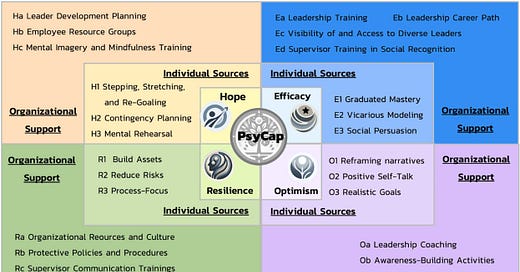It’s happening. The baby boomers are finally retiring.
Elevating aspiring diverse leaders through PsyCap
Aspiring leaders from diverse backgrounds—such as women, BIPOC, and LGBTQ+ individuals—are not only ready to fill the leadership gap left by retiring baby boomers but also to bring fresh innovations to tackle global challenges. Those with high levels of Positive Psychological Capital (PsyCap)—which includes Hope, Efficacy, Resilience, and Optimism—have an edge over those with lower PsyCap. The good news is that PsyCap can be developed and strengthened.
A recent publication from LeAD Labs director Dr. Becky Reichard, LeAd Labs alum, Dr. Poom Pitichat, and research consultant Kayla Parker encourages organizations to help diverse leaders build their PsyCap through supportive measures like employee resource groups, leadership visibility, protective policies, and coaching. These organizational supports align with personal strategies, such as re-setting goals, positive self-talk, and taking calculated risks, that boost PsyCap.
No lie, academic articles are long! Don’t worry; we’ve got you covered with multiple ways to digest this essential and timely research!
For our audiophiles.
We got you, visual learners.
Fine, you like reading!
Here’s a summary of the full piece:
Guess what? The "Silver Tsunami" is finally here—baby boomers are retiring in droves, leaving a huge gap in leadership positions. In fact, around 10,000 of them retire every single day, and many are top-level leaders. Sounds like a crisis, right? Well, it’s actually a fantastic chance to welcome a new generation of leaders who are ready to take on today’s big issues—think climate change, social justice, and the tech challenges of tomorrow.
But here’s the catch: For way too long, leadership opportunities have been handed out mostly to a select few, leaving out tons of talented people—especially women, BIPOC (Black, Indigenous, and People of Color), and LGBTQ+ folks. Even with some progress, there’s still a big gap. Globally, women hold just 32% of leadership roles. In the U.S., only 34% of Black workers and 25% of Latine workers have management gigs. It’s even tougher for those with intersecting identities—like Black women, who make up just 4.4% of managers and a tiny 1.4% of the C-suite.
And this isn’t just bad news for those missing out on leadership roles. It’s a loss for organizations, too! Diverse leaders bring fresh ideas and new perspectives, which means better decisions and more innovation. Plus, the lack of representation keeps old inequalities alive—like the wage gap. LGBTQ+ workers in the U.S. make just 89 cents for every dollar earned by the average worker, and that gap is even bigger for LGBTQ+ people of color.
So, how do we fix this? Enter Positive Psychological Capital—aka PsyCap. It’s a fancy term, but it’s all about four key motivational states: Hope, Efficacy, Resilience, and Optimism (yep, HERO for short). Research says leaders with high PsyCap are better at rallying their teams and handling challenges. And the best part? PsyCap isn’t set in stone—you can build it up with the right support and opportunities!
Organizations have a huge role to play in building up the PsyCap of diverse future leaders. Sure, individuals can work on their own growth, but they often hit structural roadblocks that need a little extra push—like mentoring programs, leadership coaching, and policies that actually take on discrimination. When organizations put their effort into building up PsyCap, they can help aspiring leaders leap over obstacles like bias and stereotypes.
Let’s break down what each piece of PsyCap means and how organizations can help grow them:
Hope
Hope isn’t just about crossing your fingers for a better future. It’s setting clear goals, figuring out the path to get there, and staying motivated—even when the going gets tough. Hopeful leaders adapt to change, and they keep their sights set on their long-term goals. Organizations can boost hope by offering development plans that help leaders map out their goals step-by-step. ERGs (Employee Resource Groups) are also great for this—they connect leaders with people who’ve been through similar struggles, creating a network that keeps the hope alive.
Efficacy
Efficacy is all about feeling like you’ve got this. It’s the confidence that you can crush any challenge that comes your way. But for many from underrepresented groups, that confidence can get chipped away by things like microaggressions or being tossed into tricky roles with a high chance of failure (hello, glass cliff!). Organizations can help build efficacy by giving aspiring leaders a chance to prove themselves, starting with smaller challenges and building up to bigger ones. Plus, it really helps to see people like you rocking leadership roles—because if they can do it, why not you?
Resilience
Resilience is like a superpower—it’s the ability to bounce back after a tough situation. For leaders who face systemic barriers, resilience can be a game-changer. Resilient leaders don’t just survive—they thrive. Organizations can help by offering training opportunities, fostering a sense of purpose, and creating a culture where people feel safe to be themselves. Protective policies, like those that tackle bias head-on, make a big difference too. They create a work environment where people can thrive, even when the going gets rough.
Optimism
Optimism means believing that your hard work is going to pay off, even when things get tricky. Optimistic leaders keep pushing forward, confident that they’ll eventually reach their goals. To boost optimism, organizations can provide coaching to help leaders see their challenges in a new light and focus on their strengths. Tools like strengths assessments and mindfulness activities are great too—they help leaders set goals that feel realistic and keep their spirits high.
Conclusion
The wave of baby boomer retirements is a big shift, but it’s also a golden chance to shake up the leadership scene. Organizations need to step up and support leaders from all walks of life. By building PsyCap—Hope, Efficacy, Resilience, and Optimism—they can help diverse leaders leap over barriers and thrive. It’s not just about helping individuals; it’s about building a whole new generation of leaders who will bring fresh ideas and creative solutions to the table. So, let’s make it happen!






